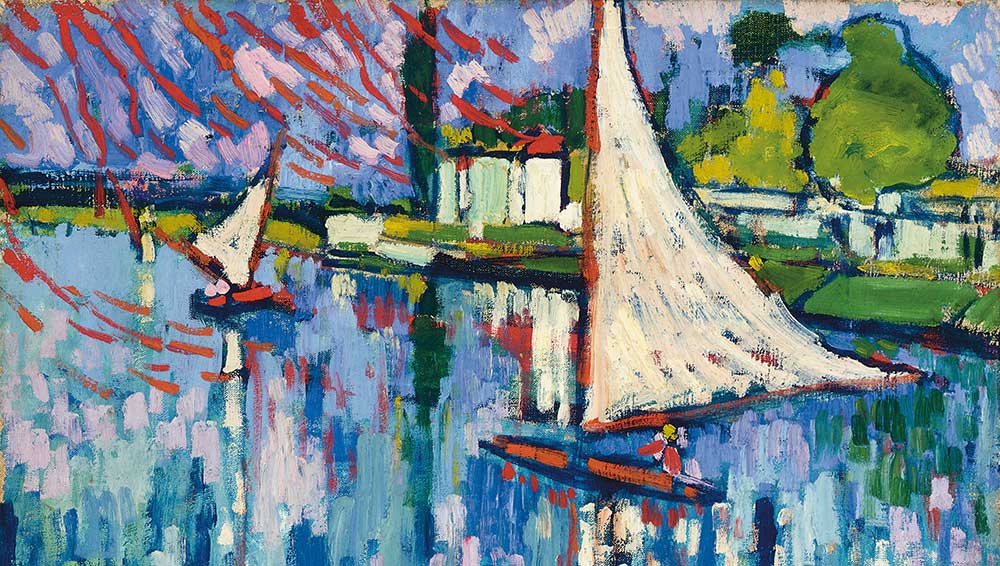
Maurice de Vlaminck. The Boats, 1905 (detail). Oil on canvas, 46.2 × 54 cm. Private collection. © VG Bild-Kunst, Bonn 2024.
Museum Barberini, Potsdam
14 September 2024 – 12 January 2025
by SABINE SCHERECK
The name Maurice de Vlaminck has a poetic ring, evoking images of the flat, wild romantic landscape of Flanders in muted tones. Instead, the visitor to the Museum Barberini is captured by his luminous colours in bold brushstrokes sketching the villages on the outskirts of Paris: quaint streets, ponds in autumn, woods in the summer and the banks of the river Seine on a clear day. De Vlaminck, born in Paris in 1876, entered the art scene as a fauvist and journeyed through different styles until his use of light became utterly arresting – unlike any other artist I have come across.
The Museum Barberini is devoting its grand halls to the French painter with the exhibition Maurice de Vlaminck: Modern Art Rebel. He is a fascinating artist who has fallen under the radar in Germany. Except for a modest appearance of his work at the first Documenta in Kassel in 1955, which reintroduced to a postwar audience what the Nazis had banned as “degenerate art”, there has been no solo show of de Vlaminck’s varied output in Germany since 1929 in Düsseldorf. Now, the Museum Barberini has drawn together loans from around the world, including the Tate Modern in London, the Museo Nacional Thyssen-Bornemisza in Madrid, the Pompidou Centre in Paris, the Van Gogh Museum in Amsterdam, the Metropolitan Museum of Art in New York and the Artizon Museum, Ishibashi Foundation in Tokyo. The Museum Barberini, holds nine of his works, more than any other venue in Germany, in its Hasso Plattner Collection. More than 70 works are now here on show.
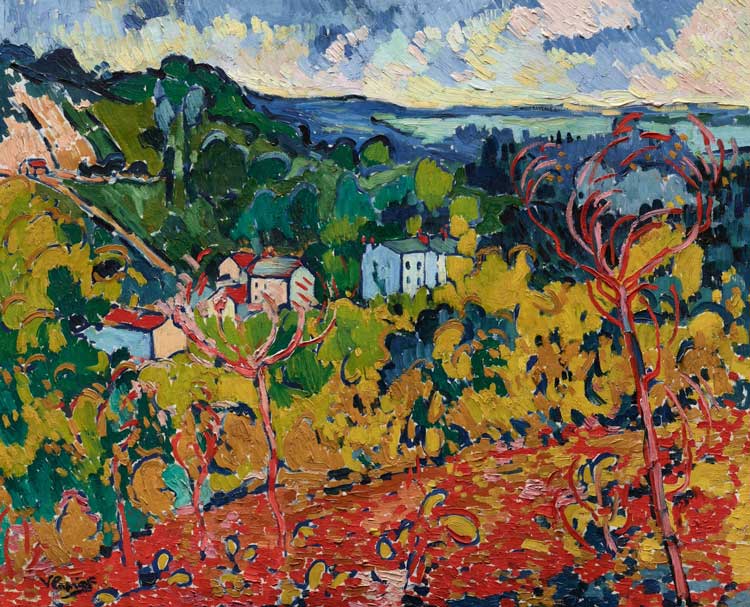
Maurice de Vlaminck. Bougival, c1905. Oil on canvas, 82.6 x 100,6 cm. Dallas Museum of Art, The Wendy and Emery Reves
Collection. © VG Bild-Kunst, Bonn 2024.
De Vlaminck’s engagement with the arts was not a given. His Flemish father taught music and ran a musical instrument shop, and his mother gave piano lessons. His first love was music. As a child, he took to playing the violin, and later earned a modest living from it for a while. Another passion was cycling, which played an important role in getting around as the family had moved to Le Vésinet, a village west of Paris, when he was three. Aged 17, he began painting as a hobby, not taking it seriously. There is a lovely quote outlining his attitude to it: “If I had decided to pursue a career in the arts, if I had thought of trying to live from the sale of my pictures, I would have never made these ‘horrible daubs’ of blue, vermilion and chrome yellow … But it was colour that I loved! And my pictures terrified everyone.” He wrote this aged 29, before the 1905 exhibition at the Salon d’Automne in Paris, which showed five of his works and marked the beginning of fauvism. By now, de Vlaminck was a married man with two children, so he had a responsibility to bring home money.
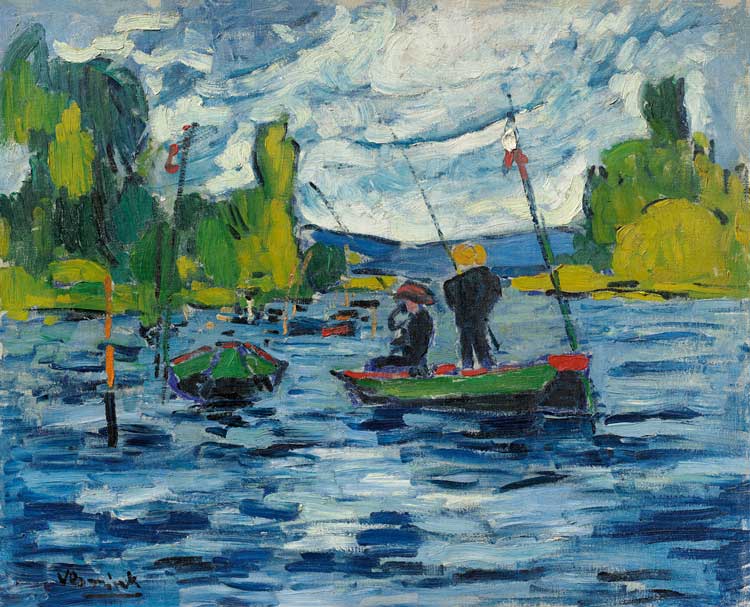
Maurice de Vlaminck. The Fishermen, 1907. Oil on canvas, 60 x 73 cm. Hasso Plattner Collection. © VG Bild-Kunst, Bonn 2024.
At the Barberini, after the initial introduction to De Vlaminck’s pictorial view of the world around villages, his images of the banks of the Seine are gathered. The cool blues and lush green tones generate an immense freshness. There is a fair amount of activity on the water, too: boats with large white sails, men fishing, boats passing under bridges. The thick, energetic brushstrokes underline the dynamic vibe and give an innocence to the pictures in the knowledge that the artist will not have laboured for hours over every leaf on a tree or every ripple on the water. As you walk through the section, you can almost feel the breeze by the water. The use of colour turns a notch towards realism.
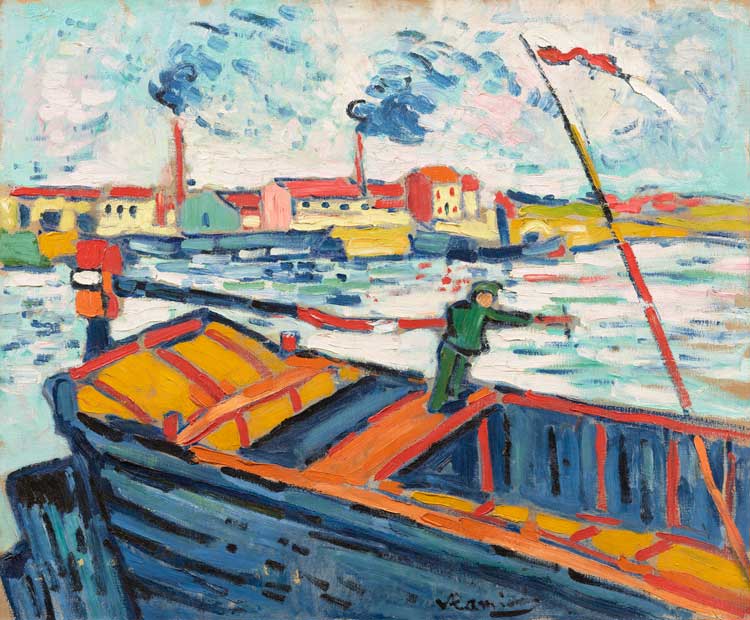
Maurice de Vlaminck. Canal Boat, 1905/06. Oil on canvas, 60.2 × 73 cm. Artizon Museum, Ishibashi Foundation, Tokyo. © VG Bild-Kunst, Bonn 2024.
Two paintings in particular grip the viewer. One is Le Havre, Le Grand Quai (1906) with its vibrant blue, green and turquoise water and its pale yellow and orange sails. In the background, towering whitewashed houses leave some space for the blue sky and floating clouds. It shows a busy port, where the viewer can sense the work. It is unlike the imagery of the impressionists, who often portrayed the lifestyle and leisure of the bourgeoisie, which de Vlaminck rebelled against.
The other, The Bridge at Chatou (1908), hints at what is to come: geometrical forms and flatter shapes enter his visual language, pre-empting a style that would be refined to perfection by Lyonel Feininger, who also moved in Paris’s artistic circles at that time. In De Vlaminck’s rendition of the bridge, the clear blue river takes up almost two-thirds of the lower part, leading the view up to the bridge. The bridge, also in blue, is hardly noticeable, sandwiched between the river and the dark blue-green mountains rising high in the background. In contrast to the previous works lining the walls, this one emanates a certain calmness.
Then come other facets of his oeuvre. There are his still lives, to which he turns in winter when the weather makes painting outside difficult. A favourite of his are oranges – or perhaps they are peaches, taking the red blush on the fruits into account. Arranged on a plate or a bowl, they are often accompanied by a jug, a vase or a pile of books. The shapes become much simpler, while the selection of colour remains restricted to orange, blue and green with only a little yellow or red. The summer fruits must have brought some joy to the home when an icy wind was howling outside, and rain and snow dominated the view from the window.
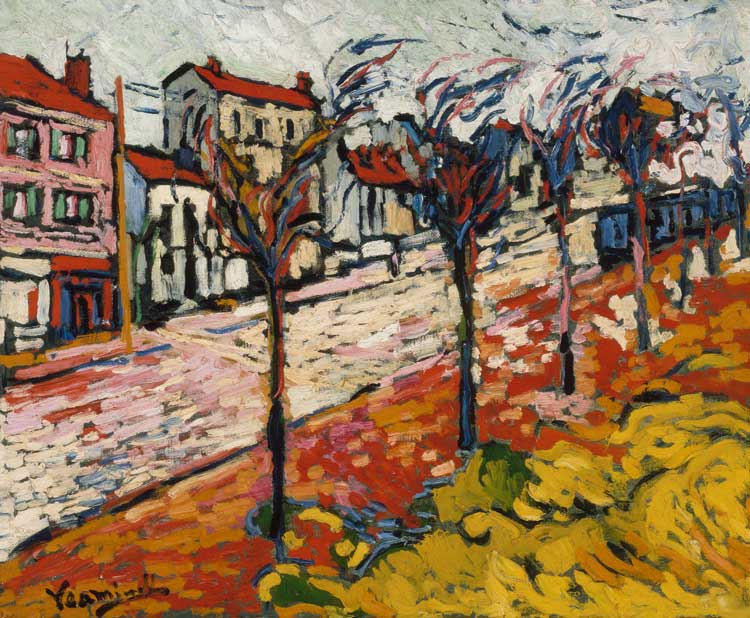
Maurice de Vlaminck. Suburban Landscape, 1905. Oil on canvas, 60,3 × 73 cm. Museum of Fine Arts, Boston, Gift and Bequest of David and Peggy Rockefeller. © VG Bild-Kunst, Bonn 2024.
The colours and shapes of these homely scenes are in stark contrast to further paintings embracing the countryside with a firework-like explosion of intense bright colours. Here, red and yellow take prime positions: flaming red is used for the trees, and ochre-yellow for fields, the ground and occasional foliage. The paint hits the canvas in smaller blobs and finer wavy lines. The Wheat Field (c1906) is clearly a nod to Vincent van Gogh, whose works he had seen. Other works echo pointillism or the emerging expressionist movement as heralded by the German artists’ group Die Brücke in Dresden, even though there is no mention of De Vlaminck travelling to Germany at this time, so it is unlikely that he saw the group’s works or was influenced by them. Nevertheless, his art found its way to Germany, including to Herwarth Walden’s gallery Der Sturm in Berlin, which championed the avant garde and included De Vlaminck in its first exhibition in 1912, alongside the likes of Robert Delaunay, Wassily Kandinsky, Ernst Ludwig Kirchner and Gabriele Münter.
The following and largest room in the exhibition holds De Vlaminck’s succeeding artistic phase, summarised under the title The Spirit of Cézanne: Fragmentation of Forms. A retrospective of Paul Cézanne at the Salon d’Automne in 1907 led De Vlaminck to revise his colour palette and take a new approach to reimagining the landscape, views of the village or boats gliding along the Seine. The colours become more muted and incorporate shades, the brushstrokes are gentler and more sensitive towards what nature presents to him. His lines are much clearer, often straighter, and leave fauvism behind. This is particularly noticeable in Landscape near Martigues (1913), showing fields in light earthy colours interspersed with shrubs and trees, with the dark blue sea in the background. It stands out because, although painted in oil, it has the light feel of a watercolour.
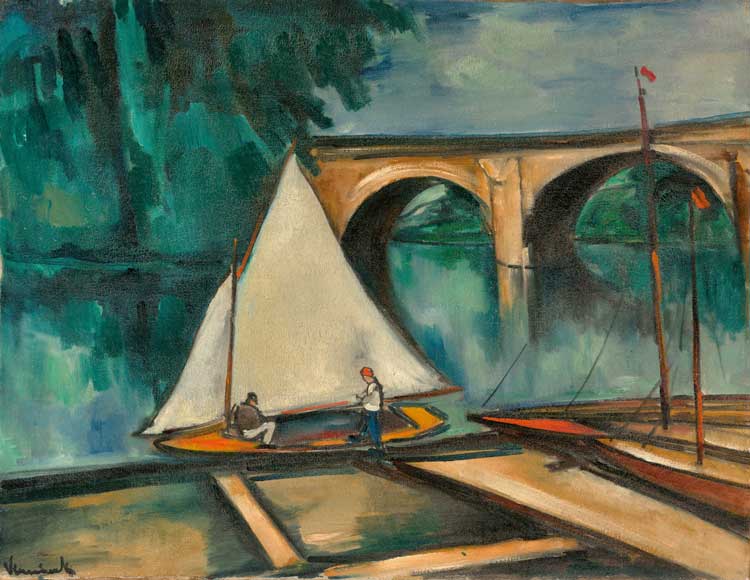
Maurice de Vlaminck. Sailboats, before 1918. Oil on canvas, 64.5 x 80.5 cm. Von der Heydt-Museum Wuppertal. © VG Bild-Kunst, Bonn 2024.
The atmosphere in Sailboats at Chatou (c1908) is far more pensive. Here, in front of the sturdy stone bridge, the boats with their white sails float on a grey Seine, reflecting the heavy clouds above, where the viewer might already hear a storm rumbling in the distance. The dark green trees are also much more sober. The same applies to Sailboats (before 1918), which is set near a different bridge. Except for the two small figures quietly engaged in preparing the boat to sail, the place is deserted, bringing a calmness and melancholy to the moment. Landscape with Red Roofs (undated) shows a few houses, and its autumnal scene has an equally sombre mood. The trees have lost their flaming red, which is now toned down with grey and brown, and the fields in background are murky brown, olive green and black. It is complemented by a grey sky that makes the heart sink. Not all the images in this section are like this, some still have the air of a late summer’s day. This mixture combined with De Vlaminck’s new clearer and calmer style makes it, for me, the strongest section of this exhibition, emotionally more stirring than the others. The pictures with the mournful mood are an intimation of what is in the final room, which resumes his work three, almost four decades on.
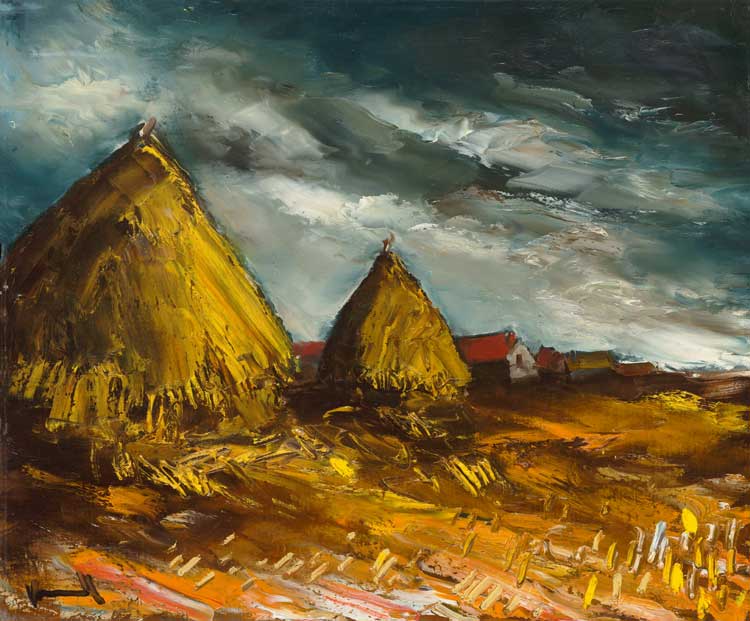
Maurice de Vlaminck. The Grainstacks, 1950. Oil on canvas, 55 x 65 cm. RMN-Grand Palais (Musée d’Orsay), on permanent loan to the Musée des Beaux-Arts de Chartres, bequest of Maurice de Vlaminck’s daughter, Solange Prével-Vlaminck.
© VG Bild-Kunst, Bonn 2024.
Here, the villages almost lie behind and De Vlaminck takes the viewer far out on to the fields, exposed to the force of the weather, where a thunderstorm is about to burst on to the scene. The most striking aspect is the glaring contrast between light and dark. In Harvest During Approaching Thunderstorm (1950), for example, the light on the cut hay and the haystacks glows against the dark and gloomy background of the sky. Another image, View of Saint-Maurice-lès-Charencey (1950), shows a snow-covered street lined by small houses where all is dark except for an eerie light rising at the horizon. By this time, De Vlaminck had lived through two world wars and had departed from the artistic movements that surrounded him in previous decades and remained untouched by the avant garde scene of this period, instead going his own way.
Both wars, though, left a mark on his life and work. During the first world war, although called up for military service, he was fortunate not to have to fight as he was the father of three daughters. It still left him shaken, and he later wrote: “All my confidence in civilisation, science, progress, socialism has been destroyed.” The war also led him to turn his back on the Paris avant garde and French modernism. Instead, he created his own style of post-impressionism. The rise of the Nazis and the second world war brought another twist. One the one hand, his works were removed from German museums as they were classified as “degenerate”; on the other, he became a sympathiser of National Socialism, publishing complimentary words on contemporary German art after a visit to the country. This did not go down well in postwar France. Yet in 1947 his fauvist period was honoured at the Galerie Bing in Paris. A decade later, in 1958, he died in the house he had bought in 1925, in a small village west of Paris.
Admittedly, it is the works from his early fauvist period, though it lasted for only two years, that give him a standing in art history as an innovator, rather than the later ones when the self-taught artist integrated the style of his peers until he detached himself again from the art scene. Yet, the pictures are a treat, and it is great to see him reintroduced to an audience outside France.
The exhibition, curated by Daniel Zamani and Anna Storm, may largely follow the simple chronology of De Vlaminck’s life, but underneath lies more. First, it reflects his evolving personality, beginning with his youthful, reckless and joyous use of bright and pure colours depicting an utterly unconventional view of the world, changing to a more considerate, traditional choice of colours bringing in shades and earthy tones combined with a more sober and mature approach to what he sees. As he becomes older, a sense of melancholy seeps into his images. By the end, after two world wars and in his 70s, dark tones prevail, producing an atmosphere of doom and gloom. Second, almost allegorical, the arrangement of the pictures also seems to mirror the four seasons from spring and summer to autumn and finally winter, where the life cycle appears to come to an end.
The final images of the exhibition, with their unusual, almost surreal lighting, left quite an impression on me. Yet, leaving the exhibition nearly at closing time, the sky offered that very type of light, with dark clouds hanging over the city and a few rays of the evening sun powering through and producing a mesmerising golden glow on buildings and trees. Unlike De Vlaminck’s scary visions, this view here is reassuring, reminding me that this rare light is a precious natural phenomenon that can delight and lift the spirit.